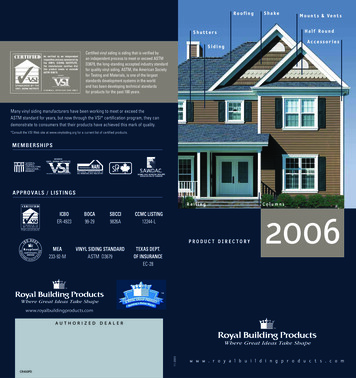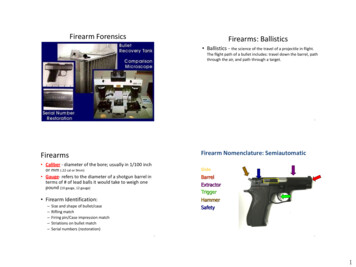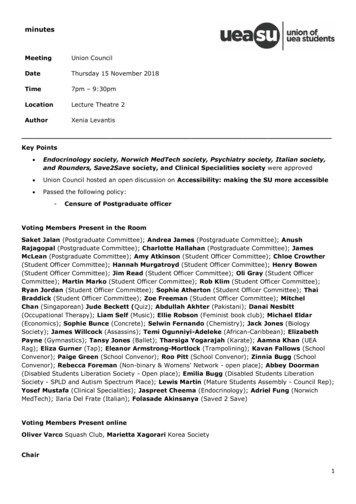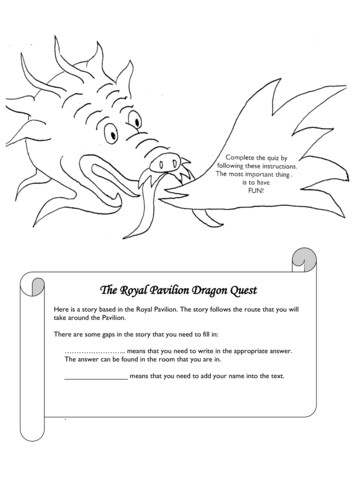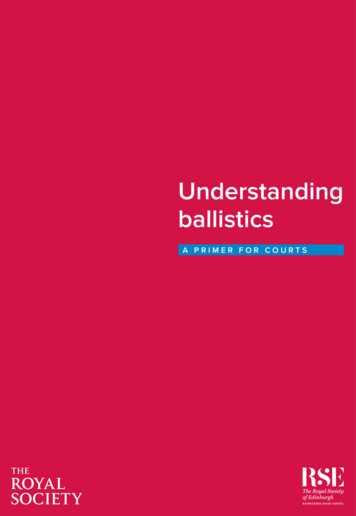
Transcription
1UNDERSTANDING BALLISTICS: A PRIMER FOR COURTSUnderstandingballisticsA PRIMER FOR COURTS
2This primer is produced by the Royal Societyand the Royal Society of Edinburgh in conjunctionwith the Judicial College, the Judicial Institute andthe Judicial Studies Board for Northern Ireland.Understanding ballistics: a primer for courtsIssued: May 2021 DES7510ISBN: 978-1-78252-485-4 The Royal SocietyThe text of this work is licensed under the terms of theCreative Commons Attribution Licence, which permitsunrestricted use, provided the original author andsource are credited. The licence is available at:creativecommons.org/licenses/by/4.0Images are not covered by this license.Requests to use them should be submittedto the below address.To request additional copies of this documentplease contact:The Royal Society6 – 9 Carlton House TerraceLondon SW1Y 5AGT 44 20 7451 2571E law@royalsociety.orgW royalsociety.org/science-and-lawThis primer can be viewed online atroyalsociety.org/science-and-lawImage credits:Figures 1 – 25: National Ballistics Intelligence Service (NABIS).Figures 26 and 27: Chemical Ballistics ResearchGroup, Liverpool John Moores University.UNDERSTANDING BALLISTICS: A PRIMER FOR COURTS
UNDERSTANDING BALLISTICS: A PRIMER FOR COURTS3ContentsIntroduction and scope61. Ballistics81.1Firearms types and operation81.2 Ammunition141.3 Calibre211.4 Internal ballistics221.5 External ballistics221.6 Terminal ballistics242. Scene interpretation252.1 Ricochet252.2 Trajectory262.3 Damage and range interpretation262.4 Wound interpretation263. Microscopy273.1 Introduction273.2 Identification of weapons293.3 Comparison of fired Items313.4 Linking ballistic material to a recovered weapon323.5 The Integrated Ballistics Identification System (IBIS)324. Mechanical condition344.1 Trigger pressures344.2 Safety devices, external and internal354.3 Unintentional discharge37
4UNDERSTANDING BALLISTICS: A PRIMER FOR COURTS5. Gunshot residue385.1 What is gunshot residue?385.2 Sampling385.3 Analysis415.4 Classification425.5 Interpretation446. Firearms classification477. The future52Appendices54Appendix 1: supplementary tables54Appendix 2: case 81
5UNDERSTANDING BALLISTICS: A PRIMER FOR COURTSScience and the law primersForewordThe judicial primers project is a unique collaboration between members of the judiciary,the Royal Society and the Royal Society of Edinburgh. The primers have been createdunder the direction of a Steering Group initially chaired by Lord Hughes of Ombersleywho was succeeded by Dame Anne Rafferty DBE, and are designed to assist thejudiciary when handling scientific evidence in the courtroom. They have been writtenby leading scientists and members of the judiciary, peer reviewed by practitioners andapproved by the Councils of the Royal Society and the Royal Society of Edinburgh.Each primer presents an easily understood, accurate position on the scientific topic inquestion, and considers the limitations of the science and the challenges associatedwith its application. The way scientific evidence is used can vary between jurisdictions,but the underpinning science and methodologies remain consistent. For this reasonwe trust these primers will prove helpful in many jurisdictions throughout the worldand assist the judiciary in their understanding of scientific topics. The primers are notintended to replace expert scientific evidence; they are intended to help understandit and assess it, by providing a basic, and so far as possible uncontroversial, statementof the underlying science.The production of this primer on understanding ballistics has been led by His HonourClement Goldstone. We are most grateful to him, to the Executive Director of the RoyalSociety, Dr Julie Maxton CBE, the Chief Executive of the Royal Society of Edinburgh,Dr Rebekah Widdowfield, and the members of the Primers Steering Group, the EditorialBoard and the Writing Group. Please see the back page for a full list of acknowledgements.Sir Adrian SmithPresident of the Royal SocietyDame Anne GloverPresident of the Royal Society of Edinburgh
6UNDERSTANDING BALLISTICS: A PRIMER FOR COURTSIntroduction and scopeThe aim of this primer is to present:1. a scientific understanding of current practice for forensic ballistics and gunshotresidue (GSR) examination used within a forensic science context;2. guidance to the judiciary in relation to the strengths and limitations of currentinterpretation and evaluations that can be made, in particular (a) the elements of thework that are subjective in nature and (b) the linking of bullets and cartridge cases toa specific weapon.The primer has been laid out in sections that provide the basic information relatingto the different elements of firearms and GSR analysis used in forensic science.In addition, the primer includes references highlighting areas for further reading,appendices and a glossary of terms.Ballistics is the study of projectiles in flight; the word is derived from the Greek,ballein, meaning ‘to throw’. Forensic ballistics is commonly accepted as any scientificexamination relating to firearms and is performed with the intention of presentingthe findings in court. This commonly includes providing an opinion as to whetherthe ammunition components may be linked to the weapon which discharged them,establishing range of fire, identifying entry and exit wounds, interpreting damage causedby gunshots and examining the mechanical condition of guns. Ironically, calculating theproperties of a bullet or projectile in flight, true ballistics, is hardly ever used, although insome rare cases it is a vital part of the firearms expert’s armoury. Somewhat unusuallyin forensic science in the UK, ballistic experts are expected to give opinions on theclassification of firearms, under the many pieces of complex firearms legislation.The study of gunshot residue, or GSR, is normally regarded as a discipline separate fromforensic ballistics but it is closely linked and is within the scope of this primer.HistoryIn some interesting early examples, interpretation of material recovered following ashooting was used to draw logical conclusions. One famous example followed thedeath of a Union General, John Sedgwick, in the American Civil War. He chided his menfor cowering from Confederate snipers, firing at 1000 yards, hubristically declaring “onecouldn’t hit an elephant at that range”, before he was killed instantly by a bullet throughhis head. The explanation was found when the offending bullet was removed and was
UNDERSTANDING BALLISTICS: A PRIMER FOR COURTS7discovered to be hexagonal in shape. This confirmed that it could only have been firedfrom a British Whitworth rifle, a weapon capable of exceptional accuracy for its day andsold in numbers to the Confederate side.Another early example includes a ‘cloth patch’ which had been wrapped around amusket ball and recovered from the wound of a murder victim (wrapping a ball ina greased cloth patch improved accuracy). The ‘cloth patch’ had been torn from asuspect’s handkerchief, thereby linking him conclusively to the murder.The first documented forensic ballistics case in the UK was in 1835. Henry Goddard, aMetropolitan Police officer, was investigating a murder where the victim had been shotwith a lead ball projectile. Upon inspection of the recovered projectile, Goddard noticeda casting mark left by the mould which had formed the lead ‘bullet’. A suspect wasidentified and a bullet mould recovered from his home. Test samples from the suspect’smould compared with the casting marks on the recovered projectile allowed Goddard toconfirm that the fatal bullet had been produced from the suspect’s mould. The suspectwas convicted of the murder.In the UK, what we would now recognise as forensic ballistics began in the 1920s whentwo pioneers, Robert Churchill and Major Gerald Burrard, started to examine bullets andcartridge cases to see if they could be linked to specific weapons. One of the first cases inthe UK to use forensic ballistics was the infamous murder of PC William Gutteridge in 1927(PC Gutteridge had been shot through the eyes, possibly because of superstitious beliefs).Robert Churchill was able swiftly to match the bullets to a gun found at a suspect’s house.Although the comparison microscopes were crude by today’s standards, the fundamentalprinciples of comparison microscopy were established by these early pioneers. After theSecond World War, the Forensic Science Service consolidated all firearms examination inEngland and Wales, and was largely responsible for setting the foundations for modernforensic ballistics examinations in the UK. Nevertheless, although technology has had animpact on the work, enabling, for example, rapid searching of bullets and cartridge cases,most forensic ballistic work remains little different from that which Churchill and Burrardpractised nearly 100 years ago.
8UNDERSTANDING BALLISTICS: A PRIMER FOR COURTS1. Ballistics1.1 Firearms types and operationThere are many different types of firearms, but only certain types are commonlyused in crime in the UK. At the time of publication, handguns and sawn-off shotgunspredominate, with over 90% of serious armed crime involving these weapon types. Thissection thus concentrates on them, although it does also refer to guns such as submachine guns and assault rifles, which, although much less common, are sometimesused by criminals.Self-loading pistols (Figure 1)Most self-loading pistols consist of aframe or receiver with a reciprocatingslide. Sometimes the barrel is fixed to thereceiver; sometimes this is a separatepart which moves during the firing cycle.Generally, self-loading pistols operateusing a spring-operated box magazine, thebulk of which is fitted into the handle ofthe pistol. They fire one cartridge for eachpull of the trigger, with fired cartridge casesbeing ejected from the weapon.FIGURE 1A self-loading pistol.Self-loading pistol operation (Figure 2)During normal operation, a magazine is filled with a number of cartridges and is insertedinto the magazine well. The pistol’s slide is pulled to the rear and released; as it travelsforward, under the force of a spring, the top cartridge is stripped from the magazine andfed into the chamber. The pistol is now cocked and loaded. From this point, assumingany safety catch is set to the fire position, pressure on the trigger will fire the weapon.On firing, recoil forces cause the cartridge case to be thrust back against the slide,which is pushed to the rear, allowing the empty, fired, cartridge case to be ejected fromthe weapon. As the slide travels forward again, propelled by a mainspring, it strips thetop cartridge from the magazine and feeds it into the chamber. The hammer or strikerremains cocked and the trigger must be released and pulled again before the newlychambered cartridge can be fired.
UNDERSTANDING BALLISTICS: A PRIMER FOR COURTS9This type of pistol will fire a single cartridge for each pull of the trigger. Once themagazine has been emptied, the pistol’s slide will be held at the rear, demonstrating tothe user that the weapon is empty.FIGURE 2Self-loading (semi-automatic) pistol operation cycle.A. Gun at rest with loaded magazine containing live cartridges.B. Slide is pulled rearwards and released forward, chambering a live cartridge from themagazine and cocking the hammer.C. The trigger is pulled; the hammer strikes the firing pin, which in turn detonates thelive cartridge, forcing the bullet down the barrel.D. Recoil forces slide rearwards, extracting the spent casing. On the forward movement,a new live cartridge is reloaded from the magazine.Illustration created by Christopher Poole, National Ballistics Intelligence Service (NABIS).
10UNDERSTANDING BALLISTICS: A PRIMER FOR COURTSRevolvers (Figure 3)Revolvers derive their name fromthe revolving cylinder that holds thecartridges. The cylindrical, rotating part ofa revolver contains separate chambersrevolving round a central axis to align theindividual chambers with the rear of thebarrel for firing. Cylinders typically hold sixcartridges, but there are exceptions.FIGURE 3Cartridge-firing revolvers generally comein one of three forms: Solid frame revolvers with the cylinderheld in the frame, fixed behind thebarrel. These are normally loaded via aslot in the rear of the frame known as agate. These are known as gate-loadingrevolvers (Figure 4). Hinge frame revolvers (Figure 5),where the frame is hinged usuallyat the front of the frame below thebarrel. Cartridges are loaded into theweapon’s chambers after the frame isbroken open. Solid frame revolvers, with a swingout cylinder (Figure 6). The cylinderis mounted on an arm, known as thecrane, which normally swings out tothe left-hand side of the weapon.A revolver.FIGURE 4Gate-loadingrevolver.FIGURE 5Hinge framerevolver.FIGURE 6Swing-outcylinder revolver.
UNDERSTANDING BALLISTICS: A PRIMER FOR COURTSRevolver operationRevolvers are designed to be fired in single- or double-action mode.In single-action mode, the hammer is manually cocked. As the hammer is raised, therevolver’s cylinder rotates automatically to bring the next cartridge to be fired beneaththe hammer. Once cocked, pressure on the trigger fires the weapon.In double-action mode, as the trigger is pulled, the cylinder rotates automaticallyand the hammer is raised almost to its rearmost position, from which point itdischarges the weapon.The fired cartridge cases remain within the weapon, unless removed by the firer.Shotguns (Figure 7)There are four main types of shotgun: single-barrelled weapons, double-barrelledweapons, pump-action weapons and self-loading weapons.Double-barrelled and single-barrelled weapon operationMost double-barrelled shotguns have a so-called break action. This means that theweapon hinges just forward of the firing mechanism, exposing the rear of the barrels.In side-by-side weapons, the barrels are laid alongside each other; in ‘over and under’shotguns, the barrels are one above the other.FIGURE 7Typical double-barrelled shotgun (top) and a shortened or ‘sawn-off’ single-barrelledshotgun (bottom).11
12UNDERSTANDING BALLISTICS: A PRIMER FOR COURTSSome double-barrelled shotguns have one trigger; some others have two. Conventionallyin double-trigger guns, the front trigger fires the right-hand side or lower barrel. On somesingle-trigger guns, the order of firing is set; in others, the order is determined by the firer,using a switch on the safety catch. The selected barrel is fired first; pulling the triggeragain will fire the other barrel.Some weapons have exposed hammers and others have internal hammers. Weaponsfitted with an external hammer must be manually cocked before the weapon willdischarge. Weapons with internal hammers are cocked automatically as the weaponis opened to be loaded.Once a cartridge is loaded into the chamber and the weapon is closed and cocked andany safety catch is set to the fire position, pulling the trigger will fire the weapon.Single-barrelled weapons are identical in operation but have only one barrel andone trigger.Pump-action and self-loading weapon operationBoth these types of weapon have a single barrel. They are magazine-fed and themagazine is usually a tube beneath the barrel. Cartridges are fed into the magazinethrough a port on the underside of the weapon. Cartridges are chambered from themagazine either by operation of a pump handle (pump-action) or by manual operation ofa bolt (self-loading). Once loaded, pulling the trigger will fire any chambered cartridge.A pump-action weapon is reloaded by operating the pump handle. The fired cartridgecase is ejected from the chamber and a fresh cartridge from the magazine is loaded.Releasing and pulling the trigger will fire this chambered cartridge. A self-loadingweapon ejects the fired cartridge case automatically from the chamber and feeds afresh cartridge from the magazine into the chamber; again, pulling the trigger will firethe freshly chambered cartridge.
UNDERSTANDING BALLISTICS: A PRIMER FOR COURTSSub-machine guns and assault rifles (Figure 8)Neither type of weapon is commonly seen in gun crime in the UK. The main differencebetween the two is that the sub-machine gun uses pistol ammunition and the assaultrifle an intermediate cartridge, ie one lower powered than a normal rifle cartridge.Both weapon types are generally ‘selective-fire’ weapons, in that they can fire singleshots, each requiring a separate pull on the trigger for each shot, or ‘full-auto’, wherethe gun will continue to discharge for as long as the trigger is depressed and there isammunition in the magazine.FIGURE 8The AK47 assault rifle (left) and MAC-10 sub-machine gun (right),both capable of fully automatic fire.13
14UNDERSTANDING BALLISTICS: A PRIMER FOR COURTS1.2 AmmunitionMetallic, centrefire, bulleted cartridgeconstruction (Figure 9)Conventional metallic, centrefire, bulletedcartridges consist of four constituent parts:a cartridge case, propellant powder, aprimer and a projectile (Figures 10 and11). The primer, the ignition system of thecartridge, sits in the base of the cartridgecase; the propellant is housed inside thecartridge case; and the projectile sits in thecartridge case mouth. In common parlance,people often refer to a round of ammunitionas a ‘bullet’ whereas technically ‘bullet’refers only to the projectile.FIGURE 9NB. In this Primer for Courts, ‘bullet’and ‘projectile’ should be regarded asinterchangeable.On firing a bulleted cartridge, the cartridgecase expands slightly, forming a tight gasseal at the rear of the barrel. This helps tomaintain sufficient pressure to propel thebullet down the barrel at optimum velocity.Metallic bulleted cartridgesin various calibres.FIGURE 10The components of a bulleted cartridge.BulletCasePropellantFlash holePrimerIllustration created by Christopher Poole,National Ballistics Intelligence Service (NABIS).
UNDERSTANDING BALLISTICS: A PRIMER FOR COURTS15Production of ammunitionConventional centrefire cartridges can be produced in one of two ways:1. Factory made. The cartridges are assembled in a factory.2. Hand-loaded/reloaded. The spent primer is removed from a previously firedcartridge case. A replacement live primer is added to this cartridge case, with ameasured quantity of propellant and a projectile, to form a new round of ammunition.Hand-loaded/reloaded cartridges are assembled somewhere other than in aconventional factory, generally at home. The constituent parts of the cartridges canbe bought separately and assembled to form whole rounds of ammunition. (Thisshould not be confused with the term ‘reloading’, which can apply to changingmagazines or inserting cartridges into a gun after discharge.)Bullet stylesBullets for use in cartridges come in a number of styles. These are categorised by shape,material and composition. Most bullets are made of lead or have lead in their composition.Some bullets have harder metal jackets, usually copper alloy or copper-plated steel. Thejackets of bullets may cover all (full-metal jacket) or part (semi-jacketed) of the bullet. In theformer, the base of the bullet is exposed, showing the (lead) core. In the latter, the base ofthe bullet is covered, exposing either a small amount of lead at the nose (soft-point) or ahole or depression (hollow-point). These are designed to expand on impact.FIGURE 11Cartridge cases, bullets, propellant and primers.
16UNDERSTANDING BALLISTICS: A PRIMER FOR COURTSHow a centrefire cartridge works (Figure 12)In a centrefire metallic cartridge, the firing pin strikes the primer in the centre of the base ofthe cartridge. The priming composition explodes and a jet of flame passes through the flashhole in the cartridge case and ignites the propellant powder within the body of the cartridgecase. The propellant powder burns, producing a large volume of gas. This expanding gaspushes the bullet out of the cartridge case and down the barrel of the firearm.FIGURE 12Centrefire primer detonation.PropellantFlash holeExplosivecompoundFiring pinIllustration created by Christopher Poole, National Ballistics Intelligence Service (NABIS).How a rimfire cartridge works (Figure 13)Rimfire cartridges are made from a thin sheet of metal folded to form the shape of acartridge. The priming composition sits in the base of the cartridge case and, duringmanufacture, is spun into the rim.Rimfire cartridges sit in the weapon’s chamber, rims against the back. The firing pin strikesthe rim at the base of the cartridge and crushes the rim against the rear of the chamber,so crushing the priming composition between the fold of metal at the base of the cartridge.A 0.22 cartridge is an example of a rimfire cartridge and is one of the most commoncalibres worldwide. See Glossary and section 2.3 for further discussion on calibre.
17UNDERSTANDING BALLISTICS: A PRIMER FOR COURTSFIGURE 13Rimfire primer ExplosivecompoundFiring pinIllustration created by Christopher Poole, National Ballistics Intelligence Service (NABIS).Propellant powder (Figure 14)Propellant powder comes in a varietyof forms and chemical compositionsdepending upon the purpose for whichit is intended. (This is dealt with in moredetail in Chapter 5.)Propellant powder burns rather thanexplodes, but it burns very rapidly whenconfined in a cartridge case in thebarrel of a weapon. The rate of burningincreases as pressure increases. Thepressure in the barrel drops when theprojectiles exit the muzzle (the front endof the barrel).FIGURE 14Smokeless propellant powder
18UNDERSTANDING BALLISTICS: A PRIMER FOR COURTSShotgun cartridge construction(Figures 15 and 16)Conventional shotgun cartridges consistof five constituent parts: a cartridge case,propellant, primer, wad and a quantity ofshot pellets or a single projectile.FIGURE 15Shotgun cartridges, common 12-gaugeand 0.410 calibre examples.While generally made of lead alloy,shotgun pellets may be made of othermaterials, including steel, bismuth andtungsten. Generally, shot are spherical.Cartridge casesShotgun cartridge cases consist of aplastic or cardboard tube, the rear ofwhich is covered with a metal cap-likestructure known as the head. Althoughgenerally made of steel, it is often platedwith brass. This portion of the cartridgecase houses the primer assembly andis generally marked with a headstamp.The headstamp usually identifies thecalibre of the cartridge case and often themanufacturing company. The side of thecartridge case often bears markings fromthe company which loaded the cartridgeor might be marked with a retailer’s nameas well as additional information such asshot size.The cartridge case contains the remainingcomponents of the cartridge.FIGURE 16A shotgun cartridge:A. Lead shotB. Plastic wadC. PropellantD. Plastic cartridge caseE. Metallic base incorporating a primerDABCE
UNDERSTANDING BALLISTICS: A PRIMER FOR COURTS19Wads (Figure 17)Wads are internal components of shotgun cartridges. Their purpose is to seal the gasesproduced by the burning propellant in the barrel of the shotgun and to protect the shot.They can be made from various substances, including plastic, fibre, cardboard andcombinations thereof.Some plastic wads include a cup-shaped section to hold the shot pellets; this is madeup of a number of petals or fingers. Conventional shotgun cartridges can containdifferent quantities of shot depending upon the use for which they are intended. Forexample, a 12-gauge cartridge will normally contain between 21 and 42 grams (g) ofshot, with between 27 g and 36 g being most common.FIGURE 17Fibre wadding, a plastic wad and lead shot.Shot pellet sizesShot pellets for use with shotgun cartridges are graded according to size. In the UK, thelarger the number, the smaller the size of the shot pellets. For example, a number 1 sizeshot will be approximately 3.6 mm diameter, whereas a number 5 will be approximately2.8 mm diameter. Numbers 5, 6 and 7 size shot are commonly used for hunting smallgame and for clay pigeon shooting; because of their availability, they are also frequentlyused in crime.
20UNDERSTANDING BALLISTICS: A PRIMER FOR COURTSBlank and tear gas cartridge construction (Figures 18 and 19)Modern blank cartridges for self-loading pistols are similar in design to bulletedcartridges with the exception that they lack a projectile. Most have a (green) colouredplastic closure at the case-mouth. The front of the cartridge case is rolled over theplastic closure to hold it in place.FIGURE 18The components of a blank cartridge.PrimerPlastic closureIllustration created by Christopher Poole, National Ballistics Intelligence Service (NABIS).Tear gas cartridges are essentially identical with the exception that they contain asmall amount of tear gas material in the form of a finely divided crystalline solid. Suchcartridges have coloured plastic closures, the colour indicating the type of tear gaschemical present. Weapons designed to fire blanks and irritant gas cartridges aresold freely in continental Europe and are often referred to as gas/alarm pistols. Thepistol discharges the irritant tear gas a short distance from the muzzle, theoreticallydeterring an attacker. In the UK they are prohibited weapons and are easily capable ofconversion to discharge a missile. Certain types of UK blank-firing weapons, incapableof conversion or discharging tear gas, are not prohibited by statute.
UNDERSTANDING BALLISTICS: A PRIMER FOR COURTS21FIGURE 19Blank and tear gas cartridges often show coloured plastic closures, typically green(blank) and red (tear gas).Tear gas-firing (or gas/alarm) self-loading pistol operationNormally, tear gas-firing self-loading pistols operate in an identical way to normalself-loading pistols, except no projectile (only tear gas) is expelled from the barrel. Inaddition, many of these pistols have a threaded muzzle to enable them to be fitted witha flare launcher, the flare being launched by using a standard blank cartridge.1.3 CalibreTrue calibre is a measure of the internal bore of a weapon. However, in common usage,calibre refers to the type of cartridge a gun is designed to fire. An example of a commonpistol calibre is the 9 mm Parabellum, the most common pistol calibre in the world.Confusingly, there are often several different designations for the same calibre, and so9 mm Parabellum is also called 9 mm Luger, 9 mm P, 9 mm NATO or 9 x 9 mm. In addition,there are other 9 mm calibres such as 9 mm Makarov and 9 mm Short. These cannot bedischarged in a 9 mm Parabellum pistol nor are they compatible with one another. For thisreason, forensic scientists should always be specific in their statements and will normallycomment on the compatibility between any weapon and ammunition examined.Calibres with metric dimensions are usually European in origin whereas those withimperial dimensions are usually North American or British in origin. Obsolete calibresare calibres for which ammunition is no longer commercially available, and weaponschambered in these calibres are often regarded as antiques under UK law.
22UNDERSTANDING BALLISTICS: A PRIMER FOR COURTS1.4 Internal ballisticsThe subject of internal ballistics covers the time from when the primer is struck until theprojectile exits the barrel.When the trigger is pulled, the firing pin will strike the primer at the base of the cartridge.This causes a shower of sparks to ignite the propellant powder in the cartridge case.The propellant powder burns at a very high rate, creating a large volume of gas and asubstantial increase in pressure. The pressure is contained by the breech block at therear of the cartridge and the barrel surrounding the cartridge, so that the pressure willact on the projectile (or the wad in a shotgun), driving it down the barrel.The rate at which the propellant burns is calculated to ensure that the pressurecontinues to rise so that the projectile travels down the barrel. One might expect,therefore, that the powder in a pistol cartridge would burn more rapidly than thepowder in a rifle cartridge, the slower burning of the rifle cartridge ensuring constantacceleration of the projectile down the longer barrel. This is the case, and also explainswhy the same projectile fired from the same cartridge but from a weapon with a shorterbarrel will produce a lower velocity than from a long barrel. Similarly, projectiles from a‘sawn-off’ shotgun or rifle will produce lower velocities.1.5 External ballisticsThe subject of external ballistics deals with the behaviour of the projectile after its exitfrom the barrel, during its flight and then when it makes contact with a target – this is thetrajectory. Many factors combine to influence the trajectory of the projectile.When in flight, the main forces acting on the projectile are gravity and air resistance (whichcan take the form of both drag and wind deflection). When looking at small arms externalballistics, gravity imparts a downward acceleration on the projectile, causing it to drop fromthe line of sight. Drag or air resistance decelerates the projectile with a force proportionalto the square of the velocity. Wind makes the projectile deviate from its trajectory.As a result of gravity, a projectile will follow a parabolic trajectory. To ensure that theprojectile has an impact on a distant target, the barrel must be inclined to a positiveelevation relative to the target line. This is known as sighting the weapon and explainswhy a weapon has to be sighted at different ranges. To give a practical example, aprojectile fired from a rifle sighted to hit a target at 150 metres might also strike the pointof aim at 50 metres but will shoot high at 100 metres and low at 200 metres (Figure 20).
23UNDERSTANDING BALLISTICS: A PRIMER FOR COURTSFIGURE 20A. An unsighted rifle will miss the aim point at 150 metres owing to the effects of gravityand deceleration on t
2 UNDERSTANDING BALLISTICS: A PRIMER FOR COURTS This primer is produced by the Royal Society and the Royal Society of Edinburgh in conjunction with the Judicial College, the Judicial Institute and the Judicial Studies Board for Northern Ireland. Understanding ballistics: a primer for courts Issued: May 2021 DES7510 ISBN: 978-1-78252-485-4
